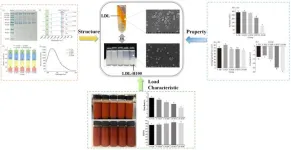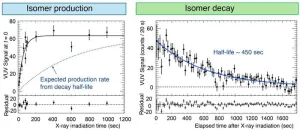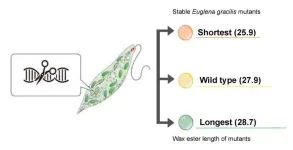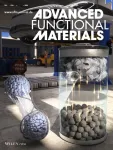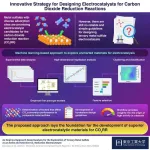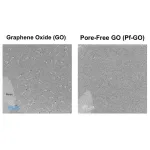(Press-News.org) In a world where organizing a simple meeting can feel like herding cats, new research from Case Western Reserve University reveals just how challenging finding a suitable meeting time becomes as the number of participants grows.
The study, published in the European Physical Journal B, dives into the mathematical complexities of this common task, offering new insights into why scheduling often feels so impossible.
“If you like to think the worst about people, then this study might be for you,” quipped researcher Harsh Mathur, professor of physics at the College of Arts and Sciences at CWRU. “But this is about more than Doodle polls. We started off by wanting to answer this question about polls, but it turns out there is more to the story.”
Researchers used mathematical modeling to calculate the likelihood of successfully scheduling a meeting based on several factors: the number of participants (m), the number of possible meeting times (τ) and the number of times each participant is unavailable (r).
What they found: As the number of participants grows, the probability of scheduling a successful meeting decreases sharply.
Specifically, the probability drops significantly when more than five people are involved—especially if participant availability remains consistent.
“We wanted to know the odds,” Mathur said. “The science of probability actually started with people studying gambling, but it applies just as well to something like scheduling meetings. Our research shows that as the number of participants grows, the number of potential meeting times that need to be polled increases exponentially.
“The project had started half in jest but this exponential behavior got our attention. It showed that scheduling meetings is a difficult problem, on par with some of the great problems in computer science.”
‘More to the story’
Interestingly, researchers found a parallel between scheduling difficulties and physical phenomena. They observed that as the probability of a participant rejecting a proposed meeting time increases, there’s a critical point where the likelihood of successfully scheduling the meeting drops sharply. It’s a phenomenon similar to what is known as “phase transitions” in physics, Mathur said, such as ice melting into water.
“Understanding phase transitions mathematically is a triumph of physics,” he said. “It’s fascinating how something as mundane as scheduling can mirror the complexity of phase transitions.”
Mathur also noted the study’s broader implications, from casual scenarios like sharing appetizers at a restaurant to more complex settings like drafting climate policy reports, where agreement among many is needed.
“Consensus-building is hard,” Mathur said. “Like phase transitions, it’s complex. But that’s also where the beauty of mathematics lies—it gives us tools to understand and quantify these challenges.”
Mathur said the study contributes insights into the complexities of group coordination and decision-making, with potential applications across various fields.
Joining Mathur in the study were physicists Katherine Brown, of Hamilton College, and Onuttom Narayan, of the University of California, Santa Cruz.
END
Unveiling the math behind your calendar
Case Western Reserve research explores statistical mysteries of everyday tasks, from Doodle polls to efficient scheduling
2024-09-13
ELSE PRESS RELEASES FROM THIS DATE:
New research finds employees feel pressure to work while sick, which has been shown to cost companies billions
2024-09-13
EMBARGOED FOR RELEASE UNTIL 9 A.M. ET ON SEPT. 13, 2024
TAMPA, Fla. (Sept. 10, 2024) – Employees often feel pressure to work while sick, leading to lost productivity, deviant behaviors such as theft and mistreatment of coworkers and intent to leave the organization, according to new research led by University of South Florida Assistant Professor of Psychology Claire Smith. The cost of such behavior, known as “presenteeism,” can be staggering – as much as $150 billion annually, according to Harvard Business Review.
The findings will be ...
Harnessing egg yolk power: A new approach to paprika oleoresin stability
2024-09-13
Paprika oleoresin (PO), extracted from chili peppers, is renowned for its vibrant color and beneficial health properties, such as antioxidant and anti-inflammatory effects. However, its lipophilic nature and sensitivity to factors like oxygen, heat, and light restrict its use in water-based foods. While previous approaches, including emulsions and liposomes, have aimed to improve PO’s stability, the results have been limited. These persistent challenges underscore the need for new stabilization methods for PO.
The study (DOI: 10.26599/FSAP.2024.9240064), led by scientists from Chengdu University and Huazhong Agricultural ...
Millions of depressed Americans could benefit from psychedelic therapy, study finds
2024-09-13
Atlanta, Georgia - In the wake of mounting evidence for the efficacy of psychedelic-assisted therapies, the U.S. Food and Drug Administration (FDA) is considering approving psilocybin, the active ingredient in “magic mushrooms,” for treating depression in the near future. As this watershed moment approaches, a critical question arises: Just how many people might stand to benefit from this promising but still unproven therapy?
Shedding light on this high-stakes inquiry, a first-of-its-kind peer-reviewed study led by researchers at Emory University, the University of Wisconsin-Madison and ...
Towards the realization of compact and portable nuclear clocks
2024-09-13
Scientists use atomic clocks to measure ‘second,’ the smallest standard unit of time, with great precision. These clocks use natural oscillations of electrons in atoms, similar to how pendulums work in old grandfather clocks. The quest for an even more precise timekeeper led to the discovery of nuclear clocks, which use the transitions of atomic nuclei instead of electrons to keep time.
A rising contender for the development of ultra-precise nuclear optical clocks is the nuclear first-excited state of 229Th isotope. Its long half-life of 103 seconds and low excitation energy of a few electron ...
Global warming's economic blow: Risks rise more rapidly for the rich
2024-09-13
In a new study by the Potsdam Institute for Climate Impact Research (PIK), researchers analysed how erratic weather events, increasingly intensified by global warming, affect global production and consumption across different income groups. The results confirm previous studies that the poorest people worldwide bear the greatest economic risks from climate change. Surprisingly, the risk for the wealthy is growing the fastest. Economies in transition like Brazil or China are also highly vulnerable to severe impacts and negative trade ...
CRISPR/Cas9 modifies euglena to create potential biofuel source
2024-09-13
News about biofuels sometimes mentions used cooking oil as a feedstock, but if these substances contain animal fat, they can solidify in colder temperatures. This happens because, chemically, the fatty acids of these and many other saturated fats have long carbon chains with single bonds. Enter the euglena. An Osaka Metropolitan University team has found a way to have one species of this microalgae produce wax esters with shorter carbon chains than usual.
Using CRISPR/Cas9 to edit the genome of Euglena gracilis, Dr. Masami Nakazawa and her team at the Graduate School of Agriculture’s ...
New 'PVDF alternative battery binder' surpasses EU environmental regulations!
2024-09-13
A team led by Dr. Hyeon-Gyun Im and Dr. Dong Jun Kang from the Insulation Materials Research Center of Korea Electrotechnology Research Institute (KERI), in collaboration with Dr. Jung-keun Yoo from KIST and Professor Jong-soon Kim from Sungkyunkwan University, have developed a technology that enhances the performance of binders—often the 'unsung heroes' in the field of secondary batteries—while using environmentally friendly materials. This technology has been published in a prestigious international ...
The Menopause Society launches Making Menopause Work™ Initiative
2024-09-13
CHICAGO (Sept 13, 2024)—Menopause is a natural life transition occurring when many women are at the “top of their game.” Unsupported menopause symptoms drive up employer healthcare costs and cause roughly $1.8 billion in missed workdays. To help employers retain these valued workers and build cultures of well-being, The Menopause Society launched Making Menopause Work™ based on new science-based Consensus Recommendations. The Recommendations are published online in Menopause, the journal of The Menopause ...
Exploring ternary metal sulfides as electrocatalyst for carbon dioxide reduction reactions
2024-09-13
One of the most promising avenues for actively reducing CO2 levels in the atmosphere is recycling it into valuable chemicals via electrocatalytic CO2 reduction reactions. With a suitable electrocatalyst, this can be achieved under mild conditions and at a low energy cost. Many types of electrocatalysts are being actively investigated, but most suffer from either low electrocatalytic activity, poor selectivity, or low stability.
Metal sulfides might hold the huge potential solution to this puzzle. By combining ionic and covalent characteristics, this unique family of materials offers good catalytic activity and energy efficiency. The ternary metal system is expected to be a better ...
Breakthrough in proton barrier films using pore-free graphene oxide
2024-09-13
Kumamoto University’s research team, led by Assistant Professor Kazuto Hatakeyama and Professor Shintaro Ida of Institute of Industrial Nanomaterials, has announced a groundbreaking development in hydrogen ion barrier films using graphene oxide (GO) that lacks internal pores. This innovative approach promises significant advancements in protective coatings for various applications.
In their study, the research team successfully synthesized and developed a thin film from a new form of graphene oxide that does not contain pores. Traditionally, ...
LAST 30 PRESS RELEASES:
Geometry shapes life
A CRISPR screen reveals many previously unrecognized genes required for brain development and a new neurodevelopmental disorder
Hot flush treatment has anti-breast cancer activity, study finds
Securing AI systems against growing cybersecurity threats
Longest observation of an active solar region
Why nail-biting, procrastination and other self-sabotaging behaviors are rooted in survival instincts
Regional variations in mechanical properties of porcine leptomeninges
Artificial empathy in therapy and healthcare: advancements in interpersonal interaction technologies
Why some brains switch gears more efficiently than others
UVA’s Jundong Li wins ICDM’S 2025 Tao Li Award for data mining, machine learning
UVA’s low-power, high-performance computer power player Mircea Stan earns National Academy of Inventors fellowship
Not playing by the rules: USU researcher explores filamentous algae dynamics in rivers
Do our body clocks influence our risk of dementia?
Anthropologists offer new evidence of bipedalism in long-debated fossil discovery
Safer receipt paper from wood
Dosage-sensitive genes suggest no whole-genome duplications in ancestral angiosperm
First ancient human herpesvirus genomes document their deep history with humans
Why Some Bacteria Survive Antibiotics and How to Stop Them - New study reveals that bacteria can survive antibiotic treatment through two fundamentally different “shutdown modes”
UCLA study links scar healing to dangerous placenta condition
CHANGE-seq-BE finds off-target changes in the genome from base editors
The Journal of Nuclear Medicine Ahead-of-Print Tip Sheet: January 2, 2026
Delayed or absent first dose of measles, mumps, and rubella vaccination
Trends in US preterm birth rates by household income and race and ethnicity
Study identifies potential biomarker linked to progression and brain inflammation in multiple sclerosis
Many mothers in Norway do not show up for postnatal check-ups
Researchers want to find out why quick clay is so unstable
Superradiant spins show teamwork at the quantum scale
Cleveland Clinic Research links tumor bacteria to immunotherapy resistance in head and neck cancer
First Editorial of 2026: Resisting AI slop
Joint ground- and space-based observations reveal Saturn-mass rogue planet
[Press-News.org] Unveiling the math behind your calendarCase Western Reserve research explores statistical mysteries of everyday tasks, from Doodle polls to efficient scheduling

